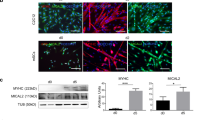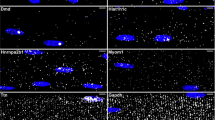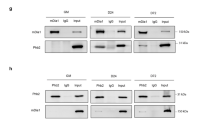Abstract
A new microtubule-binding molecule, myoseverin, was identified from a library of 2,6,9-trisubstituted purines in a morphological differentiation screen. Myoseverin induces the reversible fission of multinucleated myotubes into mononucleated fragments. Myotube fission promotes DNA synthesis and cell proliferation after removal of the compound and transfer of the cells to fresh growth medium. Transcriptional profiling and biochemical analysis indicate that myoseverin alone does not reverse the biochemical differentiation process. Instead, myoseverin affects the expression of a variety of growth factor, immunomodulatory, extracellular matrix-remodeling, and stress response genes, consistent with the activation of pathways involved in wound healing and tissue regeneration.
This is a preview of subscription content, access via your institution
Access options
Subscribe to this journal
Receive 12 print issues and online access
$209.00 per year
only $17.42 per issue
Buy this article
- Purchase on Springer Link
- Instant access to full article PDF
Prices may be subject to local taxes which are calculated during checkout




Similar content being viewed by others
References
Black, B.L. & Olson, E.N. Transcriptional control of muscle development by myocyte enhancer factor-2 (MEF2) proteins. Annu. Rev. Cell Dev. Biol. 14, 167–196 (1998).
Shimokawa, T., Kato, M., Ezaki, O. & Hashimoto, S. Transcriptional regulation of muscle-specific genes during myoblast differentiation. Biochem. Biophys. Res. Commun. 246, 287– 292 (1998).
Guo, K. & Walsh, K. Inhibition of myogenesis by multiple cyclin–Cdk complexes. Coordinate regulation of myogenesis and cell cycle activity at the level of E2F. J. Biol. Chem. 272, 791–797 (1997).
Walsh, K. & Perlman, H. Cell cycle exit upon myogenic differentiation . Curr. Opin. Genet. Dev. 7, 597– 602 (1997).
Brockes, J.P. Amphibian limb regeneration: rebuilding a complex structure. Science 276, 81–87 ( 1997).
Lo, D.C., Allen, F. & Brockes, J.P. Reversal of muscle differentiation during urodele limb regeneration. Proc. Natl. Acad. Sci. USA 90, 7230–7234 (1993).
Dorfman, J. et al. Myocardial tissue engineering with autologous myoblast implantation J. Thoracic Cardiovasc. Surg. 116, 744– 751 (1998).
Taylor, D.A. et al. Regenerating functional myocardium: improved performance after skeletal myoblast transplantation. Nat. Med. 8, 929–933 (1998).
Chang, Y.-T. et al. Synthesis and application of functionally diverse 2,6,9-trisubstituted purine libraries as CDK inhibitors. Chem. Biol. 6, 361–357 (1999).
Bains, W., Ponte, P., Blau, H. & Kedes, L. Cardiac actin is the major actin gene product in skeletal muscle cell differentiation in vitro . Mol. Cell Biol. 4, 1449– 1453 (1984).
Rosania, G.R. & Swanson, J.A. Microtubules modulate pseudopod activity at-a-distance of the cell edge. Cell. Motil. Cytoskeleton 34, 230–245 ( 1996).
Saitoh, O., Arai, T. & Obinata, T. Distribution of microtubules and other cytoskeletal filaments during myotube elongation as revealed by fluorescence microscopy. Cell Tiss. Res. 252, 263–273 (1988).
Bischoff, R. & Holtzer, H. The effect of mitotic inhibitors on myogenesis in vitro. J. Cell Biol. 36, 111–127 (1968).
Ohuchi, H. et al. An additional limb can be induced from the flank of the chick embryo by FGF4. Biochem. Biophys. Res. Commun. 209, 809–816 (1995).
Iyer, V.R. et al. The transcriptional program in the response of human fibroblasts to serum. Science 283, 83– 87 (1999).
Broxmeyer, J.E. et al. Effects of CC, CXC, C, and CX3C chemokines on proliferation of myeloid progenitor cells, and insights into SDF-1-induced chemotaxis of progenitors. Ann. NY Acad. Sci. 872, 142 –162 (1999).
Haelens, A. et al. Leukocyte migration and activation of murine chemokines. Immunobiology 195, 499–521 (1996).
Takekawa, M. & Saito, H. A family of stress-inducible GADD45-like proteins mediate activation of the stress responsive MTK1/MEKK4/MAPKKK. Cell 95, 521–530 ( 1998).
Albano, R.M., Arkell, R., Beddington, R.S. & Smith, J.C. Expression of inhibin subunits and follistatin during postimplantation mouse development: decidual expression of activin and expression of follistatin in primitive streak, somites and hindbrain. Development 120, 803–813 (1994).
Robson, L.G. & Hughes, S.M. The distal limb environment regulates MyoD accumulation and muscle differentiation is mouse–chick chimaeric limbs. Development 122, 3899– 3910 (1996).
Itoh, N., Mima, T. & Mikawa, T. Loss of fibroblast growth factor receptor is necessary for terminal differentiation of embryonic limb muscle. Development 122, 291–300 ( 1996).
Groskopf, J.C., Syu, L.J., Saltiel, A.R. & Linzer, D.I. Proliferin induces endothelial cell chemotaxis through a G protein-coupled, mitogen-activated protein kinase dependent pathway. Endocrinology 138 , 2835–2840 (1997).
Tanaka, E.M. & Brockes, J.P. A target of thrombin activation promotes cell cycle re-entry by urodele muscle cells. Wound Repair Regen. 6, 301–391 ( 1998).
Hung, D.T., Jamison, T.F. & Schreiber, S.L. Understanding and controlling the cell cycle with natural products. Chem. Biol. 3, 623– 639 (1996).
Hansen, M.B., Nielsen, S.E. & Berg, K. Re-examination and further development of a precise and rapid dye method for measuring cell growth/cell kill. J. Immunol. Methods 119, 203–210 ( 1989).
Belmont, L.D. & Mitchison, T.J. Identification of a protein that interacts with tubulin dimmers and increases the catastrophe rate of microtubules. Cell 84, 623– 631 (1996).
Lockhart, D.J. et al. Expression monitoring by hybridization to high-density oligonucleotide arrays. Nat. Biotechnol. 14, 1675– 1680 (1996).
Wodicka, L., Dong, H., Mittmann, M., Ho, M.H. & Lockhart, D.J. Genome-wide expression monitoring in Saccharomyces cerevisiae. Nat. Biotechnol. 15, 1359 –1367 (1997).
Author information
Authors and Affiliations
Corresponding author
Rights and permissions
About this article
Cite this article
Rosania, G., Chang, YT., Perez, O. et al. Myoseverin, a microtubule-binding molecule with novel cellular effects . Nat Biotechnol 18, 304–308 (2000). https://doi.org/10.1038/73753
Received:
Accepted:
Issue Date:
DOI: https://doi.org/10.1038/73753
This article is cited by
-
Target identification of small molecules: an overview of the current applications in drug discovery
BMC Biotechnology (2023)
-
Preclinical small molecule WEHI-7326 overcomes drug resistance and elicits response in patient-derived xenograft models of human treatment-refractory tumors
Cell Death & Disease (2021)
-
Chemical modulation of cell fates: in situ regeneration
Science China Life Sciences (2018)
-
Lessons from the swamp: developing small molecules that confer salamander muscle cellularization in mammals
Clinical and Translational Medicine (2017)
-
Turning terminally differentiated skeletal muscle cells into regenerative progenitors
Nature Communications (2015)



